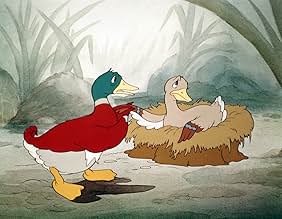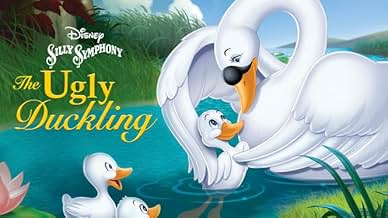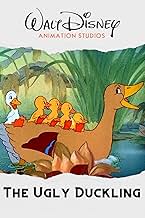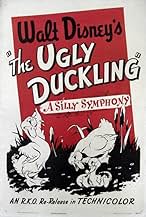IMDb-BEWERTUNG
7,6/10
3929
IHRE BEWERTUNG
Füge eine Handlung in deiner Sprache hinzuA baby duckling is shunned by his family because he is different. He is also rejected by all of the other birds and animals. Finally a mother swan adopts him as one of her brood.A baby duckling is shunned by his family because he is different. He is also rejected by all of the other birds and animals. Finally a mother swan adopts him as one of her brood.A baby duckling is shunned by his family because he is different. He is also rejected by all of the other birds and animals. Finally a mother swan adopts him as one of her brood.
- Regie
- Drehbuch
- Hauptbesetzung
- 1 Oscar gewonnen
- 1 wins total
Amanda Cewel
- Mother Duck (speaking)
- (Nicht genannt)
Tom Cotry
- Father Duck (speaking)
- (Nicht genannt)
Empfohlene Bewertungen
There is something really quite touching about this Disneyfication of the timeless Hans Christian Andersen story. We start with the expectant parents awaiting their fifth chick. It's born but clearly isn't the same as the others and it's promptly rejected. Abandoned to fend for itself, it tries to make friends but everything is new and unfamiliar. Then, fortune smiles and ... Andersen's fables always did have a valid moral underpinning them and this one seems all the more ripe for a sensitively scored and delicately drawn version that has, mercifully, been spared the traditional singing accompaniment. It's surprisingly effective, this.
A great short animation offering to Hans Christian Andersen text new touches, significances and nuances.
A remake , seductive for colors but especially for the echo in contemporary crisis , from social exclusion to need of love and the apparences, selfishness, migrants and the truth more significant than the misery of previews details.
So, I saw it after good decades and I saw it from different perspective , first in context of its time, then in the context of our time , dizzy , confuse and looking for sense.
So, easy to define it as loving and just precious. So, the ugly duckling and the steps to find its happiness.
A remake , seductive for colors but especially for the echo in contemporary crisis , from social exclusion to need of love and the apparences, selfishness, migrants and the truth more significant than the misery of previews details.
So, I saw it after good decades and I saw it from different perspective , first in context of its time, then in the context of our time , dizzy , confuse and looking for sense.
So, easy to define it as loving and just precious. So, the ugly duckling and the steps to find its happiness.
For ten years, Walt Disney's talented animators pumped out cartoon after cartoon for his 'Silly Symphonies.' Walt decided it was time to shut down one of animation's most successful series. The final film of the 'Silly Symphonies' was April 1939's "The Ugly Duckling." The series went out with a bang, with the duck short winning the Academy Award for Best Short Subject (Cartoon), the 'Silly Symphonies' eighth Oscar win. The 75-cartoon series proved to be an invaluable testing ground for Disney to create and test new techniques and technologies, resulting in Walt's first feature film, 1938's "Snow White and the Seven Dwarfs."
Disney's animators, led by Jack Cutting and Ham Luske, had completed Hans Christian Andersen's fairy tale cartoon the year before. But Walt elected to hold off its release until he secured a Radio City Music Hall premier during the Easter Week which happened to front-end Fred Astaire and Ginger Rogers' "The Story of Vernon and Irene Castle." The 1939 version of "The Ugly Duckling" was his second telling of the 1843 Andersen story about a newly hatched white duckling who clearly didn't belong to the brood of baby mallard ducks the mother had just delivered. The most recent version was much sadder than its 1931 black-and-white predecessor, which played up the humorous aspects of the tale. But the Oscar-winning 1939 cartoon's ending was more in line with the written Andersen work than the earlier one.
"The Ugly Duckling" of 1939 concluded the 'Silly Symphonies'' storied series beginning in 1929 with "The Skeleton Dance." The string of successive cartoons was intended to be a platform for mainly musically-based animations with very little yapping. Over the course of its ten-year lifespan, the symphonies introduced a variety of innovations in animation, including the first three-strip Technicolor cartoon in 1932's "Flowers and Trees," special effects, more realistic human and animal movements, the multi-plane camera, and on and on. Only the cartoon series 'Tom and Jerry' would achieve the number of Academy Award wins as the 'Silly Symphonies.' After the overwhelming success of "Snow White," Walt decided to concentrate on his ambitious full-length films and his Mickey Mouse shorts. Some say the spirit of the series was carried on by his all-musical animated feature film, 1941's "Fantasia."
Disney's animators, led by Jack Cutting and Ham Luske, had completed Hans Christian Andersen's fairy tale cartoon the year before. But Walt elected to hold off its release until he secured a Radio City Music Hall premier during the Easter Week which happened to front-end Fred Astaire and Ginger Rogers' "The Story of Vernon and Irene Castle." The 1939 version of "The Ugly Duckling" was his second telling of the 1843 Andersen story about a newly hatched white duckling who clearly didn't belong to the brood of baby mallard ducks the mother had just delivered. The most recent version was much sadder than its 1931 black-and-white predecessor, which played up the humorous aspects of the tale. But the Oscar-winning 1939 cartoon's ending was more in line with the written Andersen work than the earlier one.
"The Ugly Duckling" of 1939 concluded the 'Silly Symphonies'' storied series beginning in 1929 with "The Skeleton Dance." The string of successive cartoons was intended to be a platform for mainly musically-based animations with very little yapping. Over the course of its ten-year lifespan, the symphonies introduced a variety of innovations in animation, including the first three-strip Technicolor cartoon in 1932's "Flowers and Trees," special effects, more realistic human and animal movements, the multi-plane camera, and on and on. Only the cartoon series 'Tom and Jerry' would achieve the number of Academy Award wins as the 'Silly Symphonies.' After the overwhelming success of "Snow White," Walt decided to concentrate on his ambitious full-length films and his Mickey Mouse shorts. Some say the spirit of the series was carried on by his all-musical animated feature film, 1941's "Fantasia."
'Ugly Duckling (1939)' was the final film in Disney's "Silly Symphonies" series, and was also their only remake of a previous Symphony. Wilfred Jackson's 'The Ugly Duckling (1931)' was a rather primitive black-and-white adaptation of Hans Christian Anderson's famous tale, which drastically altered the original story to make (at least in my interpretation) a rather touching plea for racial tolerance. Jack Cutting's 1939 film is considerably more polished, animated in vivid Technicolor that speaks to the extraordinary degree of prestige that Walt Disney's company enjoyed throughout the 1930s. It is also considerably more faithful to Anderson's story, following the "ugly duckling" around the pond as he attempts to find his place in society. Unlike the 1931 duckling, which was somewhat grotesquely, Cutting's version is cute and likable, if a bit gawky compared to his ostensible siblings. Nevertheless, either bird, however handsomely they are drawn, will immediately capture your heart with their wide-eyed innocence, amplified tenfold by the persecution that they much endure for simply being "different."
The duckling's hatching causes much consternation at the adult ducks' nest, with the father understandably anxious that his wife has apparently given birth to a youngster that quite obviously didn't inherit his genes. After being unceremoniously banished from the duck family, the "ugly duckling" strikes out alone, desperate to find somewhere where he can be accepted for who he is. Glancing down into his reflection on the pond surface, in one of the short's most touching moments, the duckling sees his own reflection, hideously distorted by the water ripples, and breaks into tears. Fortunately, a happy ending is just around the corner, and the duckling's lonely honks of despair are answered in kind by a family of swans, who immediately take our hero under their wing, so to speak. Unfaultable in terms of animation, music and characterisation, 'Ugly Duckling' is a touching celebration of accepting and savouring one's own differences, and was justly awarded with an Oscar for Best Animated Short Film, Disney's seventh Silly Symphony to do so.
The duckling's hatching causes much consternation at the adult ducks' nest, with the father understandably anxious that his wife has apparently given birth to a youngster that quite obviously didn't inherit his genes. After being unceremoniously banished from the duck family, the "ugly duckling" strikes out alone, desperate to find somewhere where he can be accepted for who he is. Glancing down into his reflection on the pond surface, in one of the short's most touching moments, the duckling sees his own reflection, hideously distorted by the water ripples, and breaks into tears. Fortunately, a happy ending is just around the corner, and the duckling's lonely honks of despair are answered in kind by a family of swans, who immediately take our hero under their wing, so to speak. Unfaultable in terms of animation, music and characterisation, 'Ugly Duckling' is a touching celebration of accepting and savouring one's own differences, and was justly awarded with an Oscar for Best Animated Short Film, Disney's seventh Silly Symphony to do so.
10llltdesq
Disney's track record for adaptations of works of literature is decidedly mixed. This version of Hans Christian Andersen's, "The Ugly Duckling" is one of the most successful ones and quite deservedly won another Oscar for Uncle Walt. It's a beautiful short on all counts-animation, backgrounds, artwork, scoring, eveything-Disney at it's best. When Disney was at their best, no one could touch them. This short does justice to one of the most well-known fairy tales of all time and almost makes up for what they did to Felix Salten's "Bambi". Almost. This one should be in-print and runs on The Ink and Paint Club. An absolute masterpiece and anyone who loves animation has got to see this one! Recommended.
Wusstest du schon
- WissenswertesThe last Silly Symphony cartoon. Also, the only one to be a remake (of The Ugly Duckling (1931)).
- PatzerWhen the hero is reunited with his family, we discover that he is one of five baby swans. However, for a brief moment, six baby swans appear on screen as they swim around one another before returning to their mother.
- VerbindungenFeatured in Disney-Land: From Aesop to Hans Christian Andersen (1955)
- SoundtracksBorn to Ugly Duckling
(uncredited)
Traditional
Performed by studio orchestra
Top-Auswahl
Melde dich zum Bewerten an und greife auf die Watchlist für personalisierte Empfehlungen zu.
Details
- Erscheinungsdatum
- Herkunftsland
- Offizieller Standort
- Sprache
- Auch bekannt als
- Ugly Duckling
- Produktionsfirma
- Weitere beteiligte Unternehmen bei IMDbPro anzeigen
- Laufzeit9 Minuten
- Seitenverhältnis
- 1.37 : 1
Zu dieser Seite beitragen
Bearbeitung vorschlagen oder fehlenden Inhalt hinzufügen

Oberste Lücke
By what name was Das hässliche Entlein (1939) officially released in Canada in English?
Antwort




















